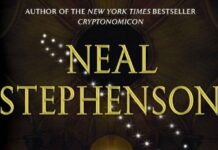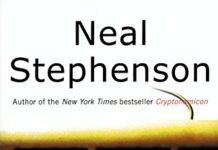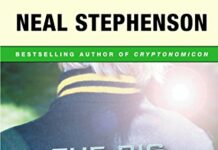
Ebook Info
- Published: 2009
- Number of pages: 1168 pages
- Format: PDF
- File Size: 13.99 MB
- Authors: Neal Stephenson
Description
With this extraordinary first volume in what promises to be an epoch-making masterpiece, Neal Stephenson hacks into the secret histories of nations and the private obsessions of men, decrypting with dazzling virtuosity the forces that shaped this century. As an added bonus, the e-book edition of this New York Times bestseller includes an excerpt from Stephenson’s new novel, Seveneves.In 1942, Lawrence Pritchard Waterhouse—mathematical genius and young Captain in the U.S. Navy—is assigned to detachment 2702. It is an outfit so secret that only a handful of people know it exists, and some of those people have names like Churchill and Roosevelt. The mission of Waterhouse and Detachment 2702—commanded by Marine Raider Bobby Shaftoe-is to keep the Nazis ignorant of the fact that Allied Intelligence has cracked the enemy’s fabled Enigma code. It is a game, a cryptographic chess match between Waterhouse and his German counterpart, translated into action by the gung-ho Shaftoe and his forces.Fast-forward to the present, where Waterhouse’s crypto-hacker grandson, Randy, is attempting to create a “data haven” in Southeast Asia—a place where encrypted data can be stored and exchanged free of repression and scrutiny. As governments and multinationals attack the endeavor, Randy joins forces with Shaftoe’s tough-as-nails granddaughter, Amy, to secretly salvage a sunken Nazi submarine that holds the key to keeping the dream of a data haven afloat. But soon their scheme brings to light a massive conspiracy with its roots in Detachment 2702 linked to an unbreakable Nazi code called Arethusa. And it will represent the path to unimaginable riches and a future of personal and digital liberty…or to universal totalitarianism reborn.A breathtaking tour de force, and Neal Stephenson’s most accomplished and affecting work to date, Cryptonomicon is profound and prophetic, hypnotic and hyper-driven, as it leaps forward and back between World War II and the World Wide Web, hinting all the while at a dark day-after-tomorrow. It is a work of great art, thought and creative daring; the product of a truly iconoclastic imagination working with white-hot intensity.
User’s Reviews
Reviews from Amazon users which were colected at the time this book was published on the website:
⭐FYI – Kindle version ends at 87% with the rest of the book being appendix and ebook extras. The LAST thing I wanted after reading this book was 13% more reading about code. :-)Wow, what an intense, laborious, interesting, pedantic, read. Told from multiple points of view, alternating between WWII and present day (late ’90’s) this is a really complex novel about … stuff. Lots and lots of stuff and detail about said stuff. Obviously, it was about breaking code in the war, also, breaking code as a hacker. It was about war and the effects of war, and the creation of the first digital computer, and the proper way to eat Captain Crunch. And some Greek mythology. Money. Cyber-everything. All over the place. It even included some hints at the creation of the NSA, which was interesting. Particularly since it’s very clear to see the need for code-breaking in the war, and what it has “morphed” into.It really was a great story, well-told. I’m glad I slogged through but I would really only recommend this book to people who like to know how things work, to the last detail. The characters were great, and fully developed. I found myself rooting for almost everybody, good guy or bad, and I suppose there’s something to that as well. Just because someone is ostensibly on a side you are not on, doesn’t mean they aren’t on your side.I had a lot of difficulty with the rotating POV’s which is part of what made this slow for me. You’d get into a storyline, and then BAM pulled out of it, and who knew when you’d get back to it. Those types of structures don’t generally bother me, but in this case it sort of always left an easy stopping point. Also, this book needed editing like NOBODY’S business. You don’t have to go step by step decoding an ENTIRE message for me to get the point. And there was one scene (a prison exchange) where it got so didactic they actually spelled out the real definition of a word conversationally. It was so inauthentic.It’s a magnum opus for sure. Worthy of its recognition and probably worthy of 5-stars. But I just couldn’t get past the bog of excessive detail enough to give it the full 5.
⭐Cryptonomicon is a book about patterns, numbers, and patterns in society. It is a macho laced adventure that takes place on two parallel time continuums involving characters of two generations of family. Mixed in this is a moral message. The whole book is a metaphor on how cryptic this moral message is. It’s the unfolding of character traits with the suggestion that through all of the history of mankind, there is a thread that can be pulled through to our origins, God. The message is cryptic and the reader only needs to tune in to it. Essentially the center theme, stated through the character Avi a Jew, is to redirect the energy put in to war driven greed towards good. Now that sounds real sappy. So Stephenson as opposed to a Marvel Action comic book, presents an intellectual action thriller.One comes to appreciate in the first story thread that takes place during WWII how much value should be placed on intelligence. Knowing what the Germans or Japanese were going to do was essential to being ready for their attacks. We woke up to this reality on December 7, 1941. The prime characters in this thread are the intellectuals that decrypt coded messages. Mixed in with the character set is one action hero that stands apart. Amazing how need to survive catapults technology. There is little moral message in this thread. Some of the characters are fictional, and some are genuine as in Alan Turing. Turning and Waterhouse, college buddies combine their efforts to give birth to what has grown up to be artificial intelligence. Yeap computer punch cards, with patterned punches decrypted enemy messages. At that time, and I believe it is still mostly true today that artificial intelligence still requires a human to input the original algorithm. I say this because the reader will find in this book the answer to that question through school: “why do I need to learn math”?On the other time continuum the second generation comes in the form of hi-tech adventure capitalists stumbling into the opportunity to recoup enough war gold to realize the kernel of capital to eliminating the greed/power seeds of war. The reader becomes aware of the fundamentals of an economy and therefore appreciates that any economy must be underwritten with the ability to pay on a promissory note, no matter what technology, that being a coin, a piece of paper, or a digital bitcoin. Yeap the book gives legitimacy to the reality of a totally digital currency.Moral Message: First you encounter these words that draw on the gods of the Greek that go back to origin, it speaks to patterns of thinking that transcends time: From the book: ““If you think of the Greek gods as real supernatural beings who lived on Mount Olympus, no. But if you think of them as being in the same class of entities as the Root Rep, which is to say, patterns of neurological activity that the mind uses to represent things that it sees, or thinks it sees, in the outside world, then yes. Suddenly, Greek gods can be just as interesting and relevant as real people. Why? Because, in the same way as you might one day encounter another person with his own Root Rep so, if you were to have a conversation with an ancient Greek person, and he started talking about Zeus, you might—once you got over your initial feelings of superiority—discover that you had some mental representations inside your own mind that, though you didn’t name them Zeus and didn’t think of them as a big hairy thunderbolt-hurling son of a Titan, nonetheless had been generated as a result of interactions with entities in the outside world that are the same as the ones that cause the Zeus Representation to appear in the Greek’s mind. And here we could talk about the Plato’s Cave thing for a while—the Veg-O-Matic of metaphors—it slices! it dices!””So past events are tied to a future of world peace at the grace of super heroes who use brain and brawn to get you there. But Stephenson gets you there with a moral message tied to Jesus Christ, the Son of God. In the end there is much dialogue that begins with a Catholic priest and Randy Waterhouse a crypto-geek in a prison cell that carries on to an executive of a very powerful Japanese firm who knows where the war gold is:From the book: ““I came to the Church because of some words.”“Words?”“This is Jesus Christ who taketh away the sins of the world,” Goto Dengo says. “Enoch Root, no one knows the sins of the world better than me. I have swum in those sins, drowned in them, burned in them, dug in them. I was like a man swimming down a long cave filled with black cold water. Looking up, I saw a light above me, and swam towards it. I only wanted to find the surface, to breathe air again. Still immersed in the sins of the world, at least I could breathe. This is what I am now.”My interpretation of this somewhat cryptic moral message enter keyword cigarroomofbooks, its in my Oct 2015 reviews
⭐As books in this genre go, it is pretty well written, with genuine wit, and some creative imagery. The plot rattles along in an unputdownable way, and I like the peppering of well-presented elementary cryptography.The style reminds me of those old H. Rider Haggard books like She: an adolescent wet dream with no real characters, but at least you know who the goodies and baddies are. You can see why male computer nerds like this sort of book, where all the beautiful girls end up going out with nerds.Some other reviewers have compared Cryptonomicon to Thomas Pynchon’s books such as Gravity’s Rainbow, Against The Day, or V. These share with Cryptonomicon a love of Mathematics and sometimes far-fetched engineering. They also share graphic descriptions of sex.However, Pynchon is a great novelist, and Stephenson is a competent one. What is the difference?Partly it is down to the care taken over the authorship. Cryptonomicon has holes in its plot that undermine its credibility: why does Andrew Loeb act the way he does? what is the point of Wing? The name Ferdinand is spelt in Japanese differently every time it is written, and I do not think we can blame the Kindle version for that, though there are plenty of examples of Kindle’ese here, such as ‘burnwad’.Partly it is down to the two-dimensionality of the characters, especially the female ones. I cannot see this book appealing to feminists, or women at all really. It is very hard to see why any of the female characters are attracted to the male ones.But the great thing about Pynchon is that his books are about something. Not just the plot, but the shape of the plot, the subplots, the nature of the characters, the descriptive passages, even the title — all resound to the same theme. Cryptonomicon in contrast reads like a collection of different ideas, loosely stapled together.To summarise, I enjoyed reading the book, kept turning the pages, and especially enjoyed the Appendix. Maybe I’d have been more generous with the stars had the book not been so eclipsed by Thomas Pynchon.
⭐Nine Hundred and eleven pages of disconnected ramblings.I’m a fan of the author and have read a few of his books and thoroughly enjoyed them.this book is a dreadful read from start to finish, no story, nothing to keep it together, it jumps from timeline to timeline with nothing to hold the threads together,Cardboard characters that are so artificial I couldnt get to liking or even empathizing with.the fact that its even less historically less historically accurate than the film U571 doesnt help anything along, neither does the really bad explanations of how cryptography works. with some random references to UNIX and Windows NT4.0 coupled with some really pointless sex scenes, and multiple descriptions of Masturbation and nocturnal emissions make this book a big fat Zero.I should have sacked this off at the 50 page mark but i stayed with it till the bitter end.Dont waste your time with this book, it is dire.if you are tempted to buy it then avoid the Kindle version and go for either paperback or hard back editions. with 900+ pages you wont need to buy toilet roll for a good few months
⭐For a long time I shied away from this author, because somehow I’d go the idea that he writes huge tomes (he does) with great wads of description (not as such). I gave him a go this time because a review said he was like Thomas Pynchon.He’s not THAT much like Pynchon tbh, but this is good. The three main story threads are set in two different time zones, WWII and today (or at least, the time the novel was written), and both deal in codes – Bletchley Park-type spy codes and code-breaking in earlier threads and computer coding later. Except, as you go along everything becomes a code. Someone walks through London streets, up and down the high curbs, and he envisions it as a code. There’s a business deal, one party pulling tricks, and the others have to read his actions as if they were a code. An intelligence officer twists a radio aerial in ways designed to fool German spies into thinking X, so he is in effect getting them to read it… like a code. It’s clever and witty, with a lot of narrative and events. There is lots of information about maths, codes, etc, along the way, which you may not like. Personally, I found it interesting.It’s not without flaws. It is, finally, too long (should have ended about the 75% mark.) Parts are absurd, and I’m not sure it ultimately adds up to much: if this were Pynchon then codes would serve as metaphor for all of Western civilisation, with well-researched and insightful observations throughout, but this is just a lark. Still, it’s intelligent, there is plenty in it, and it cracks along at a fair pace, not really developing rounded characters much but offering plenty of story that pulls you with it. I will definitely read more from this author.
⭐In each of the first 3 chapters you’re thrown into a random situation, you’re trying to familiarise yourself with new characters, new story, new location. As soon as it starts getting interesting the chapter is over and everything changes completely. It’s almost like it’s intentionally trying to build confusion just to be great later. If that’s the case, the book failed. I’m not wasting my time on another potentially pointless chapter, so all I’m left with is the first 3 incoherent chapters.
⭐I first read this when it came out (late 90’s) and enjoyed it a lot, and also learned some interesting stuff about cryptography, so I was looking forward to reading it again 20 years on. Interestingly it has not dated as much as I had anticipated, mostly because much of the most interesting stuff is set in the second world war. This time round I rather enjoyed as well the romance set in the present day. There are lots of bits that are light and sometimes quite funny, as well as some pretty gruelling treatments of events during the war. However (like most of Stephenson’s work) it is very long, and could have done with some heavy editing – sometimes it’s quite tempting just to give up on the whole thing. Overall though I’d say give it a go, though I think I still prefer Snow Crash, by the same author
Keywords
Free Download Cryptonomicon in PDF format
Cryptonomicon PDF Free Download
Download Cryptonomicon 2009 PDF Free
Cryptonomicon 2009 PDF Free Download
Download Cryptonomicon PDF
Free Download Ebook Cryptonomicon





